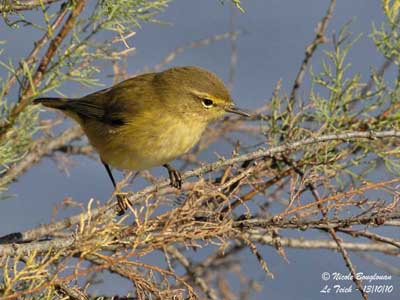
Fr: Pouillot véloce
All : Zilpzalp
Esp : Mosquitero Común
Ital: Luì piccolo
Nd: Tjiftjaf
Sd: Gransångare
Text and pictures by Nicole Bouglouan
Sources:
HANDBOOK OF THE BIRDS OF THE WORLD Vol 11 by Josep del Hoyo, Andrew Elliott and David Christie - Lynx Edicions - ISBN: 849655306X
THE HANDBOOK OF BIRD IDENTIFICATION FOR EUROPE AND THE WESTERN PALEARCTIC by Mark Beaman, Steve Madge - C.Helm - ISBN: 0713639601
THE COMPLETE BOOK OF BRITISH BIRDS – Written by “Royal Society for the Protection of Birds” experts - Préface de Magnus Magnusson - Michael Cady- Rob Hume Editors - ISBN: 0749509112
ENCYCLOPEDIE DES OISEAUX DE FRANCE ET D’EUROPE – de Peter Hayman et Rob Hume - Flammarion – ISBN : 2082009920
BirdLife International (BirdLife International)
Wikipedia (Wikipedia, The Free Encyclopedia)
Common Chiffchaff
Phylloscopus collybita
Passeriforme Order – Phylloscopidae Family
BIOMETRICS:
Length: 11-12 cm
Weight: 6-11 g
DESCRIPTION:
The Common Chiffchaff is common and widespread throughout its large range.
This bird is medium-sized. Upperparts are olive-green washed dull brown. Flight feathers and tail are brown with fine pale olive-green fringes.
Underparts are whitish or pale yellowish-white. Flanks and breast sides are tinged yellow or finely streaked yellow. Undertail coverts are creamy-white, variably washed buff. Underwing shows yellow coverts and axillaries.

Head is olive-brown with pale yellowish supercilium and fine whitish eye-ring contrasting with dark brown eye stripe.
The fine, pointed bill is dark brown to blackish. Eyes are dark brown. Legs and feet are black or dark brown.
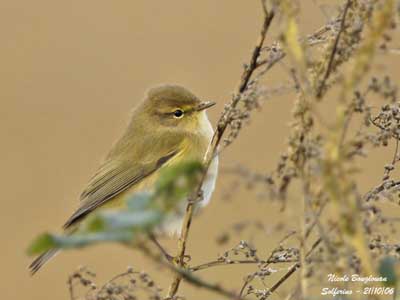
The bird in winter plumage is duller and browner.
Both sexes are similar in plumage, but female is smaller than male.
The juvenile has grey-brown upperparts and yellowish-white underparts. Throat and breast are washed buffish.
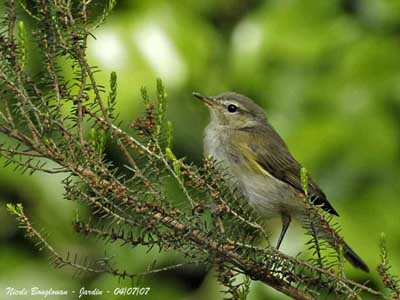
We can find six subspecies. The races differ in colour tone. There are:
P.c. abietinus ; P.c. collybita ; P.c. tristis ; P.c. brevirostris ; P.c. caucasicus and P.c. menzbieri.
VOICE: SOUNDS BY XENO-CANTO
Common Chiffchaff’s call is a simple “hooeet” or “hweet”, soft and melancholy. In autumn, we can hear some high-pitched, descending notes “cheip” or “chiip”. The contact call between mates is a short, soft “drit” or “it”.
The song is a lively series of “chiff-chaff chiff-chaff…” often preceded by dry “tret” or “trrt”.
During the spring, the male sings from treetops, but also during migrations.
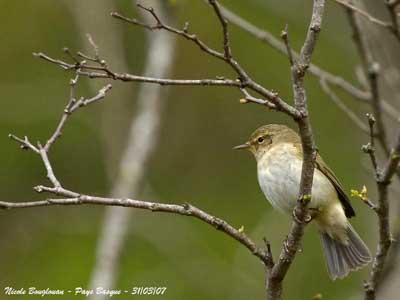
HABITAT:
The Common Chiffchaff frequents the lowland deciduous forests, the woodlands with short undergrowth, hedgerows, large gardens and parks, and reedbeds.
In non-breeding season, it frequents wooded habitats such as coastal scrub and willow thickets, but also parks, gardens and cultivated areas.
According to the range, it may be found up to 2100 metres of elevation in India. In E Africa, it winters in forests at 2500-3300 metres.
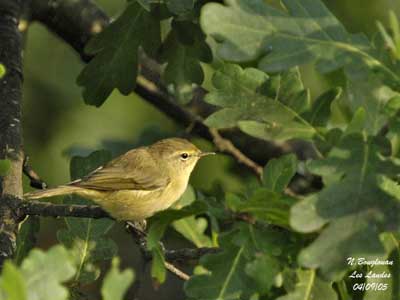
RANGE:
The Common Chiffchaff is found in northern and temperate Europe and Asia. Most of them spend the winter in S and W Europe, S Asia and N Africa.
BEHAVIOUR:
The Common Chiffchaff feeds on insects, small molluscs, seeds and berries. This bird usually forages alone, but during winter and migrations, we can see groups of up to 50 birds foraging together, sometimes with other species.
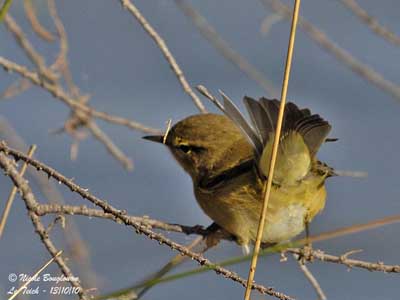
The Common Chiffchaff forages from the ground to the canopy. It takes insects from the vegetation by foraging among the foliage in trees, but also in bushes, low vegetation or directly on the ground.
It performs short sallies for insects, and hovers frequently, picking preys from the water surface. While foraging or when excited, it often dips the tail.
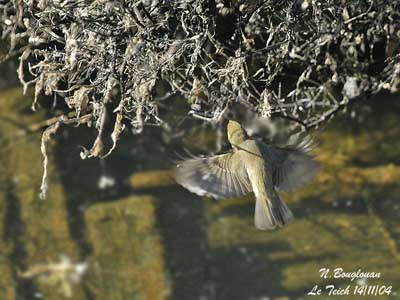
During the breeding season, the male strongly defends the territory, from the top of exposed perches. Disputes between rivals are common at the boundaries.
Some displays can be observed. When male and female meet, the male dive-bombs her and then, both perform chasing. The male gives loud calls and sings, and both mates perform bill-clicking on contact.
During the aerial displays, the male seems to float down on spread wings.
This species is usually monogamous, but some observations may indicate potential polygamy with one male defending two territories.
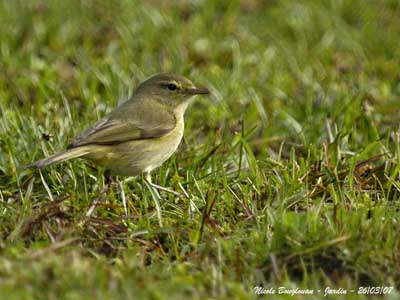
FLIGHT:
The Common Chiffchaff often hovers when foraging, taking insects from bushes and vegetation. Some of them are able to fly fairly long-distances when migrating.
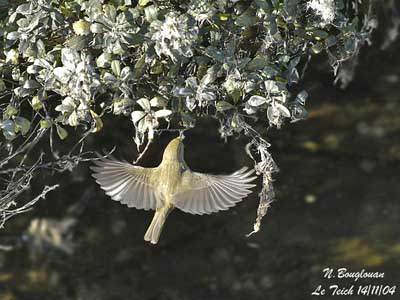
REPRODUCTION:
Breeding season occurs from April to early August. This species produces two broods in the southern parts of the range.
The nest is usually situated on the ground or between 50 cm and one metre above it. It is a ball made with dry grasses and leaves, moss, plant fibres and feathers. The nest is concealed in thick vegetation and built mainly by female.
She lays 5-6 eggs and incubates alone during 13-15 days. The chicks are fed mostly by female, but male may help sometimes. The young fledge about two weeks after hatching, and become independent 10-20 days later. They can breed at one year.
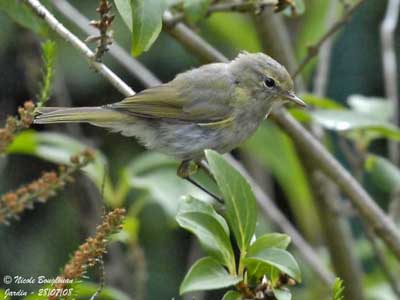
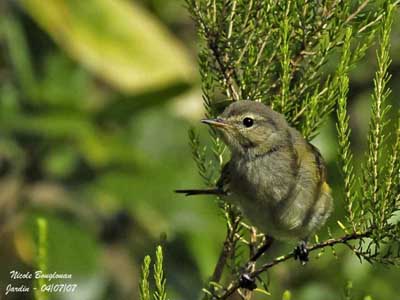
DIET:
The Common Chiffchaff feeds primarily on insects, adults, eggs and larvae, and other arthropods such as stoneflies, damselflies, grasshoppers, bugs, small butterflies and moths, mosquitoes, small bees, and also spiders.
It also takes small molluscs such as gasteropods. In autumn, it consumes seeds and berries.
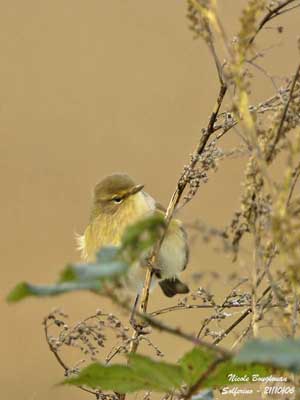
PROTECTION/THREATS/ STATUS:
The Common Chiffchaff is common or locally common according to the range.
This species is not threatened at this moment.